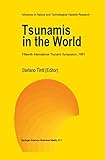Inglés estimate tsunami potential by computing seismic moment. This system holds promise for a new generation of local tsunami warning systems. Shuto (Japan) described his conversion of !ida's definition of tsunami magnitude to local tsunami efforts. For example, i l = 2 would equal 4 m local wave height, which would destroy wooden houses and damage most fishing boats. SimOes (Portugal) reported on a seamount-based seismic system that was located in the tsunami source area for Portugal. In summary, the risk of tsunami hazard appears to be more widespread than the Pacific Ocean Basin. It appears that underwater slumps are an important component in tsunami generation. Finally, new technologies are emerging that would be used in a new generation of tsunami warning systems. These are exciting times for tsunami researchers. OBSERVATIONS TSUNAMI DISPERSION OBSERVED IN THE DEEP OCEAN F. I. GONZALEZl and Ye. A. KULIKOV2 Ipacific Marine Environmental Laboratory, NOAA 7600 Sand Point Way, N. E. , Seattle, W A 98115 USA 2State Oceanographic Institute Kropotkinskey per. 6 Moscow 119034, Russia CIS The amplitude and frequency modulation observed in bottom pressure records of the 6 March 1988 Alaskan Bight tsunami are shown to be due to dispersion as predicted by linear wave theory. The simple wave model developed for comparison with the data is also consistent with an important qualitative feature of the sea floor displacement pattern which is predicted by a seismic fault plane deformation model, i. e. the existence of a western-subsidence/eastern-uplift dipole.
 Libro
en línea Editor: Dordrecht: Springer science, c1993Descripción: vi, 228 páginas : gráf., mapas ; centímetros.ISBN: 9048142830; 9789048142835; 9789401736206 (Online).Nota de acceso: Disponible para usuarios de ECOSUR con su clave de acceso Nota de bibliografía: Incluye bibliografía Número de sistema: 57521Resumen:
Libro
en línea Editor: Dordrecht: Springer science, c1993Descripción: vi, 228 páginas : gráf., mapas ; centímetros.ISBN: 9048142830; 9789048142835; 9789401736206 (Online).Nota de acceso: Disponible para usuarios de ECOSUR con su clave de acceso Nota de bibliografía: Incluye bibliografía Número de sistema: 57521Resumen:
